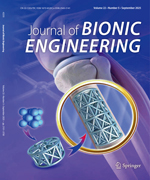|
|
Green Plant Leaf-inspired Smart Camouflage Fabrics for Visible Light and Near-infrared Stealth
Qixin Lu, Min Li, Anli Tian & Shaohai Fu
Journal of Bionic Engineering. 2022, 19 (3):
788-798.
DOI: 10.1007/s42235-022-00156-6
Due to Visible light and Near-Infrared (Vis–NIR) stealth play an important role in the commercial, military, and scientific fields, camouflage materials related to it attracted increasing attention in decades. Green plant leaves, as the most extensive background materials on the earth, were widely simulated in the camouflage materials. However, difficult full-spectrum simulation (380–2500 nm), low-similarity simulation and the complex preparation have been great challenges for Vis–NIR Camouflage Materials (Vis–NIR-CMs). Herein, basing on the color-matching principle, two novel Vis–NIR-CMs including Dark Green Materials and Light Green Materials (DGM and LGM) were facilely fabricated by simple printing organic disperse dyes including C.I. Disperse Blue 291, C.I. Disperse Yellow 114, and C.I. Disperse Orange 30 (B-291, Y-114 and O-30), and titanium dioxide (TiO2) on the viscose fabrics. Based on the excellent red edge property of B-291 and high scattering ability of TiO2, DGM and LGM exhibited generally high spectral correlation coefficients rm (>?0.95) with green plant leaves. Moreover, with the great color performance, excellent objects covering performance, low areal density (<?146.3 g cm?2), high tensile strength (>?7.7 MPa), high softness (>?81.27), high air permeability (>?45.848 mm s?1), DGM and LGM showed good simulation performance and wearing comfort to satisfy the application needs. This work presents a high-similarity Vis–NIR-CMs as a reference for full-spectrum camouflage materials, as well as low-cost and efficient preparation method is beneficial to the development of camouflage field.
Related Articles |
Metrics
|

 Table of Content
Table of Content
 Table of Content
Table of Content